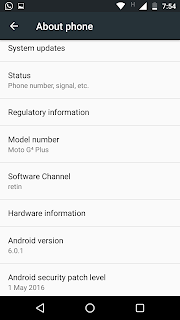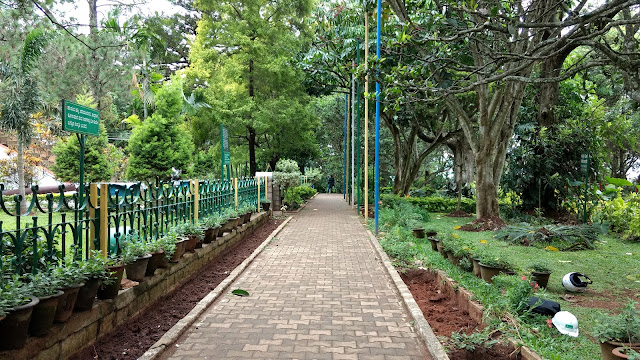| Moto G4 Plus |
The
king of mid-range territory phones, Moto G series introduced new member of its
family, the all new Moto G fourth generation earlier this month. Motorola is
now completely acquired by Lenovo and it helped them in bringing down the costs thus providing better value for money to the customers. The unique
selling point lies in its simple yet beautiful pure android experience set by
the Google. The biggest change compared to previous model is that, the fourth
generation Moto G devices are now available in two variants
1) Moto G4
2) Moto G4 plus (available in two colors, black and white)
2) Moto G4 plus (available in two colors, black and white)
The major difference between the two is the presence of 16 MP better camera with both laser & phase detection autofocus (PDAF) and a finger print scanner in Moto G4 plus . Moto G4 has "only" 13 MP normal camera borrowed from last year's Moto G3. Unlike the previous generation phones which were exclusively sold on Flipkart, this year the phones are sold only on Amazon India.
There is also another upgraded version of Moto G3 called Moto G3 turbo edition. The only upgraded feature is the turbo charging (more on it later) and priced at 12,499 rs, available on both Amazon and Flipkart. This is an outdated mobile and hence not suggested for buying. The new generation Moto G devices come with lot of improvements over the previous generation models, both hardware and software. Getting straight to the point, this review is divided into the following categories
A) Unboxing, Design, Build Quality
B) Network and Connectivity
C) Hardware (Screen, Chipset, RAM, Graphics, Battery, Camera, Sensors)
D) Software and Third Party Applications
E) Missing features and Overall score
----------------------------------------------------------------------------------------------------
A) Unboxing, Design and Build Quality:
The packing is as usual simple with good looking colorful box containing
handset with pre-inserted battery, data cable, headphones, a two pin turbo wall
charger and instructions leaflet
 |
| Contents of the box |
The
first thing you will notice when you take out the device from box is that it no
longer carries the Motorola traits. The shell is very thin and delicate made up
of normal plastic rather than polycarbonate which is more durable and provides better signal strength.
Turning
on the device brings the new refreshed "Moto" logo which is uber
cool. I am a bit surprised that the device showed up the local language first
(Kannada) which is likely due to insertion of sim card prior to switching the
device. Immediately a software update prompted with change log saying "Camera
enhancements and Stability Improvements". The software size is around 158
MB and I suggest to update it before setting up the device. Moto G4 plus is
available in two forms
a)
one with 3 Gb RAM and 32 Gb inbuilt storage for better performance and
b)
another decently specced with 2 Gb RAM and 16 Gb inbuilt storage priced at 14,999
and 13,499 rs respectively. Moto
G4 is not yet available for buying and details about its availability and
prices are yet to be announced.
 |
| Rear View |
 |
| Power/Lock, Volume up/down buttons |
The
design is flat on rear side with ridges (obviously matte finish!) and rounded
edges for better grip and handling. The phone is tad big to operate with single
hand (esp for women). Fake metallic buttons are placed on right side for
lock/unlock and volume up & down.Loudspeaker is placed along with ear piece
on the top beside the front camera along with proximity sensor and ambient
light sensor (?).
 |
| 3.5 mm jack on top |
Sadly
Moto G Plus is not IP67 rated unlike the yesteryear Moto G3 but has a nano coat
layer which can resist splashes. Despite the bigger battery, the weight of the
phone remained same (155 g) and feels light. The phone is slim by the current
standards. Check the below shot for comparison various screen sizes: Lumia 1520
(6"), iPhone 6 plus (5.5"), Lenovo Vibe K4 (5.5"), Moto G4 Plus
(5.5"), and Moto X Play (5.5").
 |
| From left to right: Lumia 1520, iPhone 6 plus, Lenovo Vibe K4, Moto G4 plus, Moto X play |
B)
Network and Connectivity
With
LTE aka 4G penetrating fast into the Indian market, it is no surprise that all
Moto G fourth generation devices are offering 4G as standard network feature.
Although, the LTE bands offered differ from model to model and country. You can
find more about LTE in my previous Moto
G3 Review . Moto G Plus has the following connectivity options
Network
|
Frequency
|
LTE Cat 6 (band 1, 3, 5, 8, 40) (4G)
|
(FDD LTE: 2100, 1800, 850, 900 MHz
and TDD LTE: 2300 MHz)
|
UMTS/HSPA+ (3G)
|
850, 900, 1700, 1900, 2100 MHz
|
GSM/GPRS/EDGE (2G)
|
850, 900, 1800, 1900 MHz
|
Wi-Fi 802.11 a/b/g/n
|
2.4 GHz + 5 GHz dual band
|
Mobile
connectivity options are solid covering most of the frequencies in GSM (2G),
UMTS (3G) and LTE (4G) networks. Kudos to Moto for providing category 6 LTE in
this price range. With Cat 6 LTE, supported by the network, speeds can reach
upto whopping 300 Mbps speed. The Wi-Fi chip is 802.11 a/b/g/n which means it
is dual band supporting 2.4 GHz and 5 GHz channels along with Wi-Fi Direct
option. Wi-Fi Direct helps you in transfer of files using Wi-Fi as medium
without a internet connection (Access point). Bluetooth version 4 has been
upgraded to V 4.2 low energy (LE) which is optimized for internet of things (IoT).
 |
| 4G test results |
 |
| Wi-Fi test results |
Speed test:
i) 4G test was performed during evening peak hours on IDEA 4G network which has
solid coverage in Bengaluru. I had run the speedtest (through mobile app) 3
times and selected the best speed. Test conditions are ground floor, indoor and
immobile. Open environment results will vary due to better signal strength.
ii)
The Wi-Fi speed is consistent thanks to the newer dual band Wi-Fi chip
C) Hardware:
When it comes to Android, better the hardware, better the experience as a
whole. The system on chip (SoC) in Moto G4 Plus is ARM v8 based Qualcomm’s®
SnapdragonTM 617 (MSM8952). It is a 64 bit Octa core processor with 1.5 GHz
clock speed and Adreno 405 GPU with 550 MHz refresh rate. Strictly speaking, 64
bit processors comes in to picture when the RAM requirement is above 4 Gb only
and it’s all marketing gimmicks. Though it is nowhere close to the Snapdragon
8xx series chipsets as offered in rivals like Lenovo's own Zuk1. The
performance is good and significantly improved over last generation. As we
discussed in the introduction paragraph, Moto G is available in two variants
that differ in their RAM and inbuilt storage (NAND). I could not test the 2 GB
RAM variant, hence cannot comment anything on its performance but, I expect it
to be fairly well as performance is mostly due to the processor speed, not RAM.
Inbuilt storage is eMMC based and nearly 24 Gb (32 Gb model) is available on
first start up. There is a slot for SD card storage which supports upto 128 Gb.
Snapdragon
617 supports full HD (FHD) resolution (1920*1080) displays and hence the new
Moto G device is upgraded to FHD from HD of G3. As I keep on telling every
time, undoubtedly screen is the best feature of the smartphone. The screen in
Moto G4 Plus is 5.5 inch FHD with resolution 1920*1080 that gives out 401
pixels per inch (PPI). It is an in-plane switching (IPS) LCD screen and is
protected by a Corning gorilla glass 3 (Same as G3) which is “scratch
resistant” but not “scratch proof”, hence it is advised to use screen guards,
especially tempered glass screen guards which interfere less with the display
output. I was sceptical about the display initially as the Moto G3 has a poor one
with faded colors. To my surprise, the colors on Moto G Plus are excellent with
well balanced brightness (Moonlight white) and photos look great on this
device, perfect for gaming and watching movies. The viewing angles are good as
it is IPS LCD. Disappointed that Motorola did not provide the latest offering
from Corning, Gorilla Glass 4 which is more durable.
Android
phones are power hungry since beginning (Of course performance comes at cost of
power). Last year Android introduced doze mode in Marshmallow that
intelligently powers down your phone or tablet when it's not in use for a long
period of time and enhances backup. With the hardware capabilities of current
android smartphones, a minimum of 3000 mAh capacity battery is standard by any
norms and Moto G plus is no exception to this. By comparison, even 50,000 Rs
Samsung flagship model S7 offers the same capacity. With heavy usage, solid one and half day backup is guaranteed. Snapdragon 617 brings the Qualcomm's quick
charge 3.0 to the handset which means provided with a faster charger, phone can
be charged quickly (turbo charging). Thanks to the provided turbo charger (12
V, 2.15 A), 15 mins of charging roughly gives 60% battery or as much as 6 hours
of power. Charging time for one full charge (dead battery to 100%) is around 1
hr 40 mins.
Camera:
 |
| Focus sensors, lens and dual LED flash |
Camera Type
|
Camera Specifications
|
Primary camera
|
16 MP, Hybrid Autofocus (PDAF + LAF), Aperture f/2.0, Dual
Tone LED flash
Video 1920*1080 @ 30 fps, 960*540 @120 fps (Slow motion),
4x digital zoom,
16 MP JPEG(4:3), 11.9 MP JPEG (16:9)
|
Secondary camera (front facing)
|
5 MP, f/2.2, Wide-Angle lens, Display flash
Video 1920*1080 @ 30 fps, 960*540 @120 fps (Slow motion),
1x digital zoom
5 MP JPEG(4:3), 3.8 MP JPEG (16:9)
|
Motorola
updated the camera aspect only in G4 plus (not G4). The 16 MP sensor with
aperture f/2.0 is equipped with a hybrid autofocus comprising high end Phase
Detection Auto Focus (PDAF) feature and a laser auto focus (LAF). When combined
together the camera can achieve very quick focus lock and hence faster photos.
To my observation, the focus time is less than a second and the images are
captured insanely fast. It is aided by color adjustable dual tone LED flash
(See above pic) set up for night portraits. The hardware is brilliantly aided
by the software offering various features like geo-tagging, drag to focus, auto
high dynamic range (HDR), slow motion videos, what not !.Tested
the camera under all possible conditions in day to day life.
Test
settings: Auto mode without HDR, Images are untouched after taken except
cropping the frames. Check out the below gallery
The
colors are little over saturated but it looks great on the device
Moto
G4 plus is capable of taking great macro shots with minimum focus distance of
just ~6 cm
The panorama resolution and quality is
just OK
 |
| Panoramic view from Nandi hills |
Digital
zoom is good but as usual pixelated on closer inspection
 |
| Normal View |
 |
| Using 4x digital zoom |
Auto
white balance works well and you can adjust it on the screen quickly at the focused
point
Location: Nandi
Hills
Night
shots are above average and are grainy
 |
| Took in the early morning just before sunrise |
Moto
G4 plus can shoot videos in FHD (1920*1080) resolution at 30 fps as well as
slow motion videos in 960*540 resolution at 120fps, once again thanks to the
snapdragon 617 chipset. The quality is average.
There
is no sophisticated optical image stabilization (OIS) but there is a digital
stabilization offered by the software which works well (but nowhere near OIS).
Check the below video
Sensors and Location services:
Moto G Plus is bundled with following sensors
Sensor Type
|
Primary Use
|
Accelerometer
|
For gaming and
navigation
|
Ambient Light Sensor
|
For automatic brightness
adjustment
|
Gyroscope
|
For Gaming and motion
detection
|
Proximity Sensor
|
For locking screen
during calls
|
Fingerprint reader
|
For secure access
|
 |
| HERE maps |
The
new sensor for fingerprint detection is a welcome change but again missed out the
magnetometer (useful for navigation). For positioning the device, Moto G4 Plus
has support for assisted GPS (A-GPS) which means it requires network
connectivity for quick locking the position to satellites. I am not sure
whether the device supports GLONASS (Russian satellite navigation system) and
BeiDou (Chinese satellite navigation system) or not as it is not mentioned in
specifications but were present in G3. Location services are well powered by the inbuilt Google maps which
has great search functionality compared to rival HERE
Maps but misses out the "full offline maps functionality"
(Hopefully Google brings it by this year end).
 |
| Basemark OS II |
Benchmark Tests: I performed the Basemark OS II benchmark free version which included few basic tests like memory read and write, graphics, calculation speed etc. Basemark OS is a cross platform benchmark software available on three OS and scores across all the devices. Check the result (higher the score better the result)
 |
| Android Marshmallow |
D) Software: My experience with Android is still in infancy. Moto G4 plus is bundled with the latest Google offering Android Marshmallow (v 6.0.1) upgradable to Android N when released. The UI has not much changed compared to Lollipop on G3 since Marshmallow is more of a performance upgrade. And as expected, the OS is pretty stable and fast.
Google
play store is well organized, easy to search and install apps & games
quickly without much trouble and the app updates are prompted gently. The onscreen navigation is simple with cool transitions. High end graphic games
like Asphalt 8 are well handled without any hiccups.
Personal
assistant "Google now" is available for all Android devices and does
the same job as Siri in iPhone and Cortana in Windows Mobile. It has evolved a lot
during the last one year and tracks your emails, daily activity etc perfectly.
Audio player interface is simple and the quality is good.
Third
Party Applications: Come on, its Android !
E) Missing Features and Overall Score:
Glance feature Always on display (Can observe this feature in initial image
where the time and other information is displayed under lock screen). Always on
display is available in few high end android phones and requires display memory
for the panel which is expensive and hence unavailable. Double tap to lock screen or
unlock screen is missing. It is available in similar priced android phones like
of Asus made Zenfones and low priced Lumia phones since last 3 years. Once again Moto
G misses out the near field communication (NFC) which is not really essential
at least in Indian market but its always good to have the extra capabilities.
Super sensitive touch is absent which means it cannot work when wearing gloves. Other missing
features include hardware camera button, reverse USB type C etc. All
these feature are not deal breakers for most users but enhance the phone
experience. Features I could not test include the audio recording,
water resistant test and call quality.
Overall Score
Design and Build Quality: 8/10
Network and Connectivity Features:
10/10
Screen: 8.5/10
Other Hardware: 8/10
Software Overall: 9/10
Camera 8/10
Final verdict: Worth buying
Kindly share the review if you like it, thanks for reading.
Kindly share the review if you like it, thanks for reading.






























